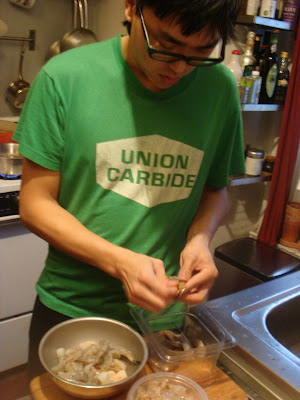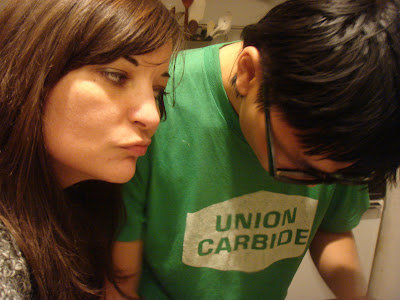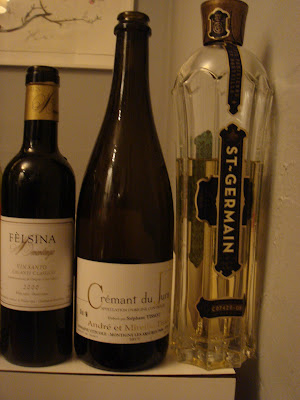
Persimmon season is fall/early winter. Two varieties, Fuyu and Hachiya (pictured), can be found in abundance in Chinatown. Fuyus, shaped like flattened globes and gold-orange in color, remain firm when ripe. In contrast, Hachiyas are orange-red in color and acorn-shaped. They are mushy-soft when ripe and are similar in flavor to, Cachi, the Italian persimmon that I fell in love with when working in Venice. The problem is that Hachiyas are picked hard and can take up to three weeks to fully ripen. In order to speed up the ripening process, I tried out a new technique: freeze the persimmon for 24 hours and then thaw in the fridge. The slow freezing/thawing worked and the persimmon became mushy soft, ready to use. My theory is that in slow freezing, ice crystals form, which rupture the cell walls, in effect, tenderizing the fruit.

Jane's Mom, Rhys, kindly gave me Cecilia Chiang's book "The Seventh Daughter." In it is a recipe for dessert soup made from a puree of walnuts and dried dates. It inspired me to make a savory walnut soup. Here, I make the base for the soup by sweating shallots in EVO with a sprig of thyme. Once the shallots were soft, I added dry sherry and cooked it sec.

I toasted walnuts in the oven and added them to the base of shallots and thyme. Then I added chicken stock to cover and simmered until the walnuts became soft. Puree, pass, adjust with sherry vinegar, and, voila, walnut soup. The walnut flavor was really intense, perhaps, too intense. I alway seek to emphatically emphasize the featured ingredient in my recipes. In this case, I feel that the walnut flavor can be diluted and still shine through as the star player. In the future, there are two adjustments that I'd like to try. First, I'd like to start by rendering bacon and then sweating the shallots in the bacon fat. Additionally, I want to add peeled, diced, yukon gold potato to the toasted walnuts and chicken stock. I'm confident that these changes, made in the correct proportions, will make the soup's flavor rounder without compromising its essential walnut essence.

Live Maine sea urchins. I have to send a huge shout out to Michael Vernon of Lobster Place, and formerly my chef/mentor at Geisha, for getting me these impeccable urchins.

Urchins are beautiful. When you handle them wear gloves. I made the mistake of using my bare-hands and received a nasty irritating rash for my indiscression. It was later pointed out to me that sea urchin spines are toxic.

Full fridge, still life. One of the challenges of preparing restaurant-style food at home is the lack of fridge space for all the mise en place.

Right after New Years, I saw eels at the fish counter at Citarella and realized that they must have been ordered with the Italian "Feast of the Seven Fishes" in mind. On Christmas and New Years it is traditional for Italians and Italian-Americans to consume eel. But, those Citarella eels were dead and I figured, correctly, that I could find live eels in Chinatown. I found these two eels at the new Hong Kong Market on Hester St and they were swimming vigorously in a clean tank with a flock of their brothers and sisters. I had the fish monger kill the eels, which he did unskillfully, as evidenced by the large cuts behind the eels heads. I would have gone for the throat and made a small cut so as not to disturb the loin meat.

Eels are scary looking creatures. I had irrational feelings of dread as I confronted this eel on my board. Perhaps it was the smell. It wasn't fishy or "off," but rather strong, musky, and fear-inducing. I'm proud of my self for finding the gumption to go ahead and cut and get the job done.

Filleting eel is just like filleting any other round fish. It helps if you nail the eel to the cutting board with a nail through the eye. I didn't do this, however, and got it done.

Eel fillets have lots of little bones. I got out the tweezer and tried to pull them out. No can do. And then I looked at the eel recipe in TK's "Under Pressure." They leave the bones in and if it's okay with them, the kings of fussy food, it's okay with me.

I wasn't happy with the uneven portioning. Most of this had to do with the hack-like way in which the fishmonger killed the eels. He made some big cuts into the loin when he gutted them, which made it impossible to portion evenly. Oh well, lesson learned. Next time, I'm really going to buck up and kill the eels with my own hands and do the job with some precision. Another lesson learned was to braised the eels with the skin on. It helps the fillets to retain a nicer shape. The eel proved to be really meaty and held up to long, long cooking. My reasoning for the 4 hour cooking time was to try and soften, or ideally, dissolve the tiny bones.

Eel sauce. I braised the eels in my mom's "red" broth. It contains pigs feet (blanched and washed), water, ginger, garlic, star anise, cinnamon stick, cloves, soy, and sugar. After braising, I cleaned the sauce by passing it until nothing remained in the passet, and then thickened with small amount of corn starch slurry.

I pureed the persimmon pulp with sugar and lemon juice. Then I froze the puree in fleximolds for 2 hours. This was paired with a granita made from celery juice and lemon segment dice. Celery-persimmon is an unusual combination that tastes great. I first combined the ingredients in Venice as an accompaniment to a Branzino crudo and it's become a fall/winter Wu signature.

Use scissors to carefully cut away the "mouth" on the bottom side of the urchin. Then scoop out the gonads, the culinary delicacy, and discard the remaining black viscera. Rinse the gonads, or uni in Japanese, in cold water.

Clean sea urchin gonads. Also known as uni. These were delicious.

Patrick rolling doufu (soybean sheets) knots. Patrick's cuisine draws on his cooking experiences in China and, throughout, Southeast Asia.

Finished knot to be braised and served with shimp, pomelo, shallots, and cilantro.

Peeling shrimp.

Stove are lit up.

Jane always come up huge during these dinner parties -- special touches like hand written menus and parting gifts for the guests.

Impromptu smoker for frankinscense. Frankinscense is an aromatic resin obtained from trees of the genus Boswellia. It used in incense as well as in perfumes. The resin has been a valuable trading commodity on the Arabian peninsula for over 5000 years. Spices, their trade and history, are a major source of inspiration for Patrick's cuisine.

Patrick felt frankinscense would pair well with a fatty fish, like hamachi. Here he cold smokes hamachi with a "tear" of frankinscense.

Waggaman, first to arrive, is put to work picking tarragon plouches.

L'eau de haricot. I cooked borlotti beans, like I would for a pasta e fagioli, with carrot, onion, celery, garlic, leek, and a lot of rosemary. Maybe would have been better to call the dish: Acqua del fagiolo. After gelatin filtration, we were left with this clean, complex full-flavored, amber-clear liquid.

Contemplation.

Tasty.

A la minute prep. Patrick was dans le merde and we diced the hamachi to order.

The smoking did not transfer the flavor of the resin to the fish. In the future, under less hectic conditions, a longer smoke might produce better results. In a last minute improvisation, Patrick grates frankinscense directly onto the hamachi.

Hamachi, passionfruit, tarragon, frankinscense.

Plating uni.

Maine sea urchin, romaine, radicchio, green apple, yuzu-scented dashi. Amazing, seasonal product with a few carefully chosen embellishments. This is my kind of food.

Marked with a pin.

Periwinkles, tamarind, pepper, salt, lime. This was a winner. The tamarind sauce for the periwinkles was delicious. As was the "street food" pepper, salt, lime paste dipping sauce (2/3 coarse mignonette pepper, 1/3 kosher salt, juice of 1 lime).

Pinning periwinkles.

Mike and Sheala.

Grinding.

Nice conversation.

Popping persimmon out of the fleximolds.

Frozen persimmon, celery granita, lemon. I used this sweet-savory course as a mid meal, palate cleanser, representing a division between the small plates and the larger courses.

Grinding.

Sauteing shrimp. They were perfectly cooked, and I'm a hard critic.

Sweethearts (grease spots on camera lens).

Workin'

Doufu knot, shrimp, pomelo, shallot, cilantro

Grinding

Grinding.

The crew: Sheala Hansen, JP Howley, Mike Waggaman, Patrick Hansen, Jane D'Arensbourg.

Workin'. Here I "velvet" flounder. Coat slices of fish with beaten egg white and a mixutre of corn starch, water, and vegetable oil. Then poach/fry at 250 degrees. This is a Chinese cooking technique that can also be applied to chicken and beef.

Walnut soup, velveted Long Island flounder, parsnip, brussels, cranberries (sloppy presentation). The seasonal accompaniments all worked: parnsip contributed sweetness and earthiness; the brussels were earthy/funky; the cranberries, rehydrated in a light orange syrup, provided sweetness, and much needed acidity.

Grinding.

Star Anise-Braised eel, watercress, soy sprouts, mint, scallions, frisee. This was yummy comfort food (and the bones weren't really noticeable).

Listening to the Eel schpiel before tucking in.

Black sesame, jackfruit, wolfberries, osmanthus.

Patrick prepares the Gong Fu tea service. This elaborate ceremony, provided dramatic theater at the table, and immense pleasure on the palate. It was super refreshing after a long meal.

Pouring the water.

Pouring the steeped tea into the serving pot.

I'm doing the itsy bitsy spider.

Tea ready to be served.

Patrick serves the tea using wooden tweezers. The tea is meant to be drunk in three sips.

Mike and Sheala.

Poached quince, cream, cardamom syrup, pumpernickle croutons.

Still life: Liquids

The line up.

Some great cremant de Jura made by Stephan Tissot. Also a nice German Riesling and a pinot blanc from Alsace.

Some nice reds from France: 1. a syrah/granache blend and 2. a somethin/sumthin and 3. G-Spot, a Pinot from the Loire. I was unable to take good mental wine notes by this point.

We finished up with a really nice Vin Santo and then made St. Germain digestifs.